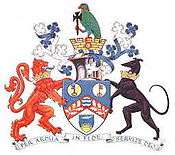London Borough of Sutton
| London Borough of Sutton | |||
|---|---|---|---|
| London borough | |||
| |||
 Sutton shown within Greater London | |||
| Sovereign state | United Kingdom | ||
| Constituent country | England | ||
| Region | London | ||
| Ceremonial county | Greater London | ||
| Status | London borough | ||
| Admin HQ | Sutton | ||
| Created | 1 April 1965 | ||
| Government | |||
| • Type | London borough council | ||
| • Body | Sutton London Borough Council | ||
| • Leadership | Leader & Cabinet (Liberal Democrat) | ||
| • Mayor | Councillor Muhammad Siddiq[1] | ||
| • MPs |
Tom Brake LD Paul Scully Con | ||
| • London Assembly | Steve O'Connell AM for Croydon and Sutton | ||
| • EU Parliament | London | ||
| Area | |||
| • Total | 16.93 sq mi (43.85 km2) | ||
| Area rank | 282nd (of 326) | ||
| Population (mid-2014 est.) | |||
| • Total | 198,134 | ||
| • Rank | 88th (of 326) | ||
| • Density | 12,000/sq mi (4,500/km2) | ||
| • Ethnicity[2] |
70.9% White British | ||
| • ONS code | 00BF | ||
| Time zone | GMT (UTC0) | ||
| • Summer (DST) | BST (UTC+1) | ||
| Postcodes | SM, KT, CR | ||
| Area code(s) | 020 | ||
| Police force | Metropolitan Police | ||
| Website |
www | ||
The London Borough of Sutton (![]() pronunciation ) is a London borough in South West London, England and forms part of Outer London. It covers an area of 43 km2 (17 sq mi) and is the 80th largest local authority in England by population. It is one of the southernmost boroughs of London. It is south of the London Borough of Merton, west of the London Borough of Croydon and east of the Royal Borough of Kingston Upon Thames. The local authority is Sutton London Borough Council. Its principal town is the eponymous Sutton.
pronunciation ) is a London borough in South West London, England and forms part of Outer London. It covers an area of 43 km2 (17 sq mi) and is the 80th largest local authority in England by population. It is one of the southernmost boroughs of London. It is south of the London Borough of Merton, west of the London Borough of Croydon and east of the Royal Borough of Kingston Upon Thames. The local authority is Sutton London Borough Council. Its principal town is the eponymous Sutton.
The Borough has some of the schools with the best results in the country.
A Trust for London and New Policy Institute report on levels of poverty throughout Greater London described Sutton as "not especially deprived, but not as prosperous as places such as Richmond or Kingston." It noted that Sutton had the highest rate in London of pupils achieving 5 A* – C GCSEs.[3] In December 2014 Sutton was described by a senior Government official as the most "normal place in Britain".[4] In connection with this, the leader of Sutton Council described the borough as "quietly brilliant", and noted that 91% of residents say it is "a great place to live".[5]
Low levels of recorded crime are a feature of the borough, being among the lowest in London. An Ipsos MORI poll in 2014 found that 97% of residents felt safe in the borough during the day, and 71% felt safe at night, a higher figure than in 2011.[6]
The 2014 Family Hotspots Report, on the best places in England and Wales for families to live, placed three areas within the borough among the top 10 places in London. The areas were identified as postcodes SM1, SM2 (Sutton town) and SM3 (Cheam).[7][8] A Rightmove study in 2015 found that Sutton was the fourth happiest borough in which to live out of 33 in London.[9] It achieved the same placing in the 2016 survey.[10]
In 2014, a survey by eMoov (Property Hot Spot Index) found Sutton to be the easiest place in the country in which to sell a property.[11] It was shown in a national detailed Land Use Survey by the Office for National Statistics in 2005 that the London Borough of Sutton had the highest proportion of land taken up by gardens, 35.1%, of any district in England; this compared with the London Borough of Harrow and Bournemouth, second and third greatest respectively.[12]
The London Borough of Sutton was one of the four "vanguard areas" selected in 2010 for the Big Society initiative.[13]
History
The borough was formed in 1965 by the merger of the Municipal Borough of Sutton and Cheam with the Municipal Borough of Beddington and Wallington and Carshalton Urban District which had previously been part of Surrey.
Districts
.jpg)
The borough includes the areas:
- Bandon Hill
- Beddington
- Beddington Corner
- Belmont
- Benhilton
- Carshalton
- Carshalton Beeches
- Carshalton on the Hill
- Cheam
- Hackbridge
- Little Woodcote
- North Cheam
- Rosehill
- St. Helier
- South Beddington
- Sutton (principal town)
- Sutton Common
- Sutton High Street (located within Sutton)
- The Wrythe
- Wallington
- Woodcote Green
- Worcester Park
Surrounding area
 |
Kingston | Morden; Wimbledon | Mitcham |  |
| Ewell | |
Croydon | ||
| ||||
| | ||||
| Epsom | Banstead | Purley |
Culture and leisure

The London Borough of Sutton was once made up of rural villages, associated with feudal and royal estates. The "village feel" persists, and places in the borough such as Carshalton, Cheam and Belmont continue to be referred to as villages. The historic development of the borough is reflected in the number of heritage areas designated as conservation areas and as areas of special local character.[14] Descriptions of a selection of the borough's cultural institutions and attractions are set out below.
The Charles Cryer Theatre, Carshalton
There are frequent productions at The Charles Cryer Studio Theatre, which is situated on the High Street (number 39) in Carshalton Village. [15] It was opened by His Royal Highness Prince Edward in 1991. [16] As well as drama and musicals, productions include comedy and dance. With material ranging from Shakespeare to Chekov to panto and children's favourites, the theatre's aim is to balance popularity with quality. The theatre also serves as a concert venue for local bands and has played host to the popular local Rockshot festival. The theatre is named after the man who led the campaign to open the Secombe Theatre, Sutton, listed below.[17]
The Secombe Theatre, Sutton town centre
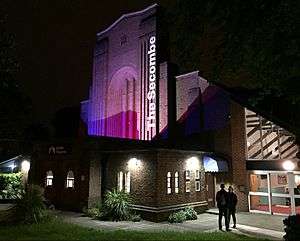
The Secombe Theatre (named after Sir Harry Secombe) is in Cheam Road, adjacent to the Holiday Inn Hotel. The theatre was opened by Sir Harry, who lived in Sutton for over 30 years of his life. [18] The theatre was created out of a former Christian Scientist church building originally dating from 1937.[19][20] The main auditorium seats 396 (or 343 if the orchestra pit is in use), and there is a large multi-purpose function room attached. The Secombe Theatre is operated in conjunction with the Charles Cryer Studio Theatre, named after the man who led the campaign to open the Secombe Theatre. (The Charles Cryer Theatre is in a converted hall in nearby Carshalton – see entry above). Productions at the Secombe have ranged in content from modern productions to new twists on older, more established plays. Some productions have been produced locally, while others have come as part of touring groups. From time to time comedians and musicians have appeared at the theatre.[21]
In 2014, because of local council budget cuts, the venue was, along with its sister theatre, the Charles Cryer Theatre in Carshalton, identified by the Theatre Trust as one of 33 theatres in the country for inclusion on its "At Risk" register.[22] The risk of closure spurred celebrity intervention in favour of the two theatres: writer, actor, comedian and BBC presenter Tim Vine, called on Sutton Council to reconsider its proposals.[23] On 10 November 2014 the local council announced that four organisations submitting outline bids to take over the two theatres had been invited to submit full business cases by 12 December. The council worked with the Theatres Trust and Sutton Centre for Voluntary Services to help bidders through the bidding process.[24] On 15 January 2015 the bid by the new "Sutton Theatres Trust" (STT) was given approval by the council's environment and neighbourhood committee to take over the theatres, thus saving them from closure.[25]
Carew Manor, Beddington

Beddington Park is the location of Carew Manor which was the home of the Beddington branch of the Carew family. The Grade I listed great hall,[26] which boasts a fine hammerbeam roof, survives from the Tudor house along with part of the early 18th-century orangery built around the orange trees planted by Sir Francis Carew in the 16th century and claimed to be the first in England. In the grounds is an early 18th-century Grade II* listed dovecote.[27] Archaeologists have recently discovered a Tudor garden including a grotto at Carew Manor, believed to have been created by Sir Francis Carew in the 16th century. There are tours of the great hall organised by the London Borough of Sutton Museum & Heritage Service.
Church of St Mary the Virgin, Beddington, Sutton

The Grade II* listed 14th-century flint parish church of St Mary's occupies a prominent position in Beddington Park, immediately south of what is now Carew Manor School and which was from the late Middle Ages the seat of the Carew family. It contains an organ screen by William Morris. The church is designated at Grade II for the following principal reasons:[28]
- It has substantial amounts of fabric from the 14th and 15th centuries
- It was extensively restored and provided with an extremely elaborate and interesting mid-Victorian decorative scheme.
- It has monuments and other fixtures of importance from c. 1200 to the 20th century, including font and Carew tombs.
- The Morris and Co. organ is of special note, and the Last Judgment reredos is unusual.
River Wandle


The River Wandle is a 9 miles (14 km) long river which flows through four southwest London boroughs, including Sutton. It passes through Croydon, Sutton, Merton, and Wandsworth where it joins the River Thames. The river changed from being a mainly rural one lined with a scattering of watermills at the beginning of the 19th century to a heavily built-up one by the 1930s. In the second half of the 20th century the river changed again, as the local authorities made improvements to its visual appearance and restored it as a habitat for wildlife.[29] Much of the River is accessible using the Wandle Trail, which passes through Sutton borough at Beddington, Hackbridge and Carshalton (including Grove Park in Carshalton Village).
Little Holland House, Carshalton
Little Holland House in Carshalton Beeches was the home of the artist Frank Dickinson (1874–1961). Dickinson's Arts and Crafts style interior was influenced by John Ruskin and textile designer and artist William Morris. The house contains many of his art works. Admission is free and the house is open 1.30–5.30pm the first Sunday of each month plus Bank Holiday Sundays and Mondays.[30]
Sutton Library, Sutton town centre
Sutton Library is situated close to the top of the town, near St Nicholas Church and the Holiday Inn Hotel, and is part of a complex which contains the Civic Offices, home of Sutton Borough Council, and the Sutton College of Liberal Arts. It is the largest library in the borough. Originally opened in 1975, it was extensively refurbished in 2004 to meet changing customer needs. It was the first public library to appoint a library writer-in-residence; the first to establish a CD and video lending library; and the first to offer a full public library service on Sundays. The library is arranged over four storeys, and the lending and reference facilities extend to a reader's lounge; café and shop; IT facilities; opportunities to listen to music; and a children's library themed around the world's environments.[31]
Sutton Life Centre, Sutton
The Sutton Life Centre is an £8 million community facility designed to improve life chances for younger people and encourage good citizenship. Its key feature – the lifezone – is a virtual street, a room with screens on all walls showing real-life scenes from Sutton's streets. It also has a library, a café, a climbing wall, and community, eco, sports, youth and media zones.[32] It tries to encourage community engagement and involvement. It was opened on 27 October 2010 by Deputy Prime Minister Nick Clegg.[33]
Honeywood Museum, Carshalton

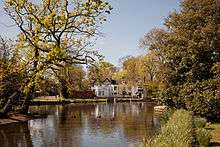
Honeywood is a large house at the western end of Carshalton Ponds. At its earliest it dates from the 17th century but has been much extended and restored, particularly in the period 1896 to 1903 when a large Edwardian wing was added to the south side. It now houses the London Borough of Sutton's main Museum and has a local history collection, including objects that date back to the Bronze Age. The museum has recently been refurbished, reopening in May 2012 with enhanced features. Among others improvements, there are now expanded displays about the river Wandle and its influence on the life of the area, including an interactive map.[34]
Arts Network Sutton
Arts Network Sutton "promotes, champions, nurtures and acts as a voice for the arts" in the borough. Taking over from the former Sutton Arts Council, it was put in place in April 2014, and launched by the Mayor of Sutton in June. It co-ordinates the arts locally and works together with regional and national arts bodies, informs the local arts community about arts initiatives, seeks out funding for local projects and runs events.[35]
Public art in Sutton town centre
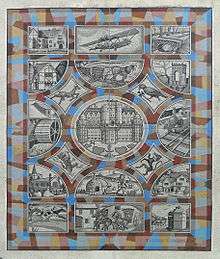
There are a number of examples of public art in Sutton town centre, ranging from building-height murals, to sculptures to an armillary. These are all fully described in the article on the town of Sutton itself. Of particular borough-wide note is one of the murals, which is in the form of a mosaic measuring 9 metres (30 feet) in height and 5 metres (16 feet approximately) in width, and covering the whole of a three-storey wall in the town square near the Waterstones bookshop. It was made from vitreous ceramic tesserae (small tiles made of glass and clay), and put in place in 1994. It was commissioned to celebrate Sutton's heritage, and shows several aspects of the borough's heritage and local history in a geometric pattern of nineteen panels. The centre-piece is the depiction of Henry VIII's palace at Nonsuch. Other panels depict armorial bearers from the old local families, as well as industrial and architectural heritage.[36]
Whitehall Gallery, Cheam
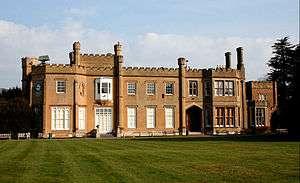
Whitehall is a timber framed and weatherboarded house in the centre of Cheam village. It was originally built in about 1500 as a wattle and daub yeoman farmer's house but has been much extended. The external weatherboarded appearance dates from the 18th century. In the garden there is a medieval well which served an earlier building on the site. Now an historic house museum, the building features a period kitchen, and house details from the Georgian, Victorian and Edwardian eras.[37] The museum temporarily closed in 2016 to allow for a £1.6m refurbishment of the building. It will reopen in 2017 with improved facilities.[38]
Nonsuch Mansion, Cheam

Nonsuch Mansion is a Gothic revival mansion within Nonsuch Park. The service wing is occasionally open to the public. It is a popular place for wedding receptions, as it is available for hire. In medieval times it was part of the three thousand acre manor of Cuddington. The mansion was originally built in 1731–43 by Joseph Thompson and later bought by Samuel Farmer in 1799. He employed Jeffry Wyattville to rebuild it in a Tudor Gothic style in 1802-6. Farmer was succeeded by his grandson in 1838 under whom the gardens became famous. Nonsuch Mansion bears a resemblance in its design to the original design of Nonsuch Palace, whose construction was begun by King Henry VIII in the 16th century. Built within the north porch of the mansion is a block from the original Nonsuch Palace that bears an inscription which means "1543 Henry VIII in the 35th year of His reign."[39][40]
Listed buildings
Within the London Borough of Sutton there are 147 Grade II listed buildings, six Grade II* listings, one Grade I listing, 4 'B’ listings and 6 C listings.[41]
Governance
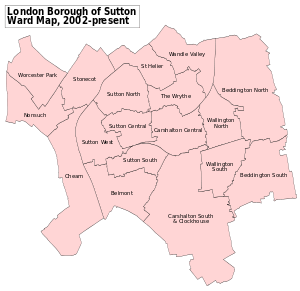
Local council seat distribution as of May 2014:
| Party | Seats | |
|---|---|---|
| Liberal Democrat | 45 | |
| Conservative | 9 | |
| Total | 54 | |
The main local government of the borough is Sutton London Borough Council. The Council has had a Liberal Democrat administration since 1986. From 1965–1986 Conservatives administered the council. At the London local elections, 2010 the Liberal Democrats returned 43 councillors, the Conservatives 11 and the Labour Party lost all of its seats on the council.
Councillor Ruth Dombey is the Leader of the Council. The Leader of the Opposition is Councillor Graham Whitham and Deputy Leader of the Opposition: Councillor Tim Crowley. Graham Tope, later Lord Tope was the Leader of the Council from 1986 to 1999.
- National Politics
Sutton is divided into two parliamentary constituencies, Sutton and Cheam and Carshalton and Wallington with one member of the Parliament each:
| Party | Member of Parliament | Constituency | |
|---|---|---|---|
| Conservative | Paul Scully, replaced Paul Burstow in the 2015 General Election | Sutton and Cheam | |
| Liberal Democrat | Tom Brake, replaced Conservative Nigel Forman in the 1997 General Election | Carshalton and Wallington | |
- London Assembly
As the London Assembly has eleven London-wide members from all four main parties, the borough shares its geographical London Assembly member with neighbouring Croydon, in its elections which began in 2000 and take place with the election of the Mayor of London, a Conservative Assembly member has gained a large majority (in other words it is arguably a safe seat). The current Assembly Member is Steve O'Connell, then a local councillor from Croydon, who was elected with an increased share of the vote of 43% following fellow conservative Andrew Pelling's time representing the area.
- European Parliament
Sutton is represented in the European Parliament by the London constituency.
Big Society
The London Borough of Sutton was one of the four "vanguard areas" selected in 2010 for the Government's Big Society initiative. Sutton was chosen because of its reputation for having a strong sense of community, its active voluntary sector and its track record of devolving power to its neighbourhoods.[13]
Notable individuals




Notable individuals closely associated with the borough:
- Tom Abbott, broadcaster for Golf Channel and NBC
- Kim Acourt, model
- Martin Adams, BDO Darts World Champion
- Joan Armatrading, singer-songwriter & musician, lived in Sutton in the 1970s.
- Harry Aikines Aryeetey, athlete, attended Greenshaw High School
- Terry and Jonathan Austen, micronation creators
- Ben Barnes, actor, attended Homefield Preparatory School.
- Jeff Beck, musician – rock guitarist: one of the three noted guitarists to have played with the Yardbirds (the other two being Eric Clapton and Jimmy Page).
- David Bellamy, broadcaster and botanist, attended Sutton Grammar School.
- Sally Bercow, wife of the current Speaker of the House of Commons, John Bercow.
- Johnny Borrell, guitarist, singer and frontman of the band Razorlight.
- Seb Brown, AFC Wimbledon goalkeeper, attended Cheam High School
- Paul Burstow, MP for Sutton and Cheam was born in Carshalton, and was educated at Carshalton College
- Angus Calder, writer, historian and academic
- Rob Davis, Lead Guitarist of Mud
- Lord Peter Ritchie Calder, author, journalist and academic
- Sir Nicholas Carew, sheriff of Surrey and Sussex, Master of the King's Horse, executed by Henry VIII
- Sir Francis Carew, grandson of the above, of Beddington Park, Elizabethan horticulturalist
- Noël Coward, actor and playwright lived in Lenham Road, Sutton until the age of six
- James Cracknell OBE, Olympic gold medallist in rowing
- Quentin Crisp, writer, author, raconteur
- Clark Datchler, lead singer of Johnny Hates Jazz
- Sir John Fellows(c. 1671–1724), of the South Sea Company
- Eddie George later Lord George (1938–2009) GBE DL, PC,(16 September 1938 – 18 April 2009), Governor of the Bank of England 1993–2003.
- Les Gray, lead vocalist of Mud
- Lord Hardwicke, (1690–1764) Lord Chancellor[42]
- Darius Henderson, footballer
- Catherine Holman, actress
- James Hunt, Formula One winning racing driver.
- Penelope Keith, actress, and famous for her role in The Good Life, was born in Sutton.
- Ruth Kelly, former Labour Party member of parliament and Transport Secretary, attended Sutton High School.
- Rebecca Litchfield, photographer.
- Peter Loader, cricketer
- Bradley McIntosh, member of former chart topping band S Club 7, attended Greenshaw High School.
- Sir John Major KG CH, former Conservative Prime Minister
- Gary Mason, boxer
- Katie Melua, singer, songwriter, and musician
- David Mitchell (born 1980), cricketer
- Simon Conway Morris, palaeontologist, specifically research of Burgess Shale type fauna
- Dave Mount, drummer of Mud
- Joshua Pascoe, Played Ben Mitchell in Eastenders
- Peter Alfred Penfold, CMG, OBE,diplomat, attended Sutton Grammar School.
- Conrad Pugsley, known as the Wizard Man of Sutton
- Michael Reeves, writer and director of horror classic Witchfinder General
- Dr John Radcliffe, royal physician and MP see Radcliffe Camera, Radcliffe Infirmary and the Radcliffe Observatory[42]
- Michael Reeves, film director and screenwriter, best known for the 1968 film Witchfinder General
- Sir Cliff Richard, singer and songwriter, attended Stanley Park Junior School
- Rebecca Romero, Olympic cycling champion
- Joanna Rowsell, Olympic gold medallist in women's pursuit cycling
- Dora Russell (born Dora Black, 1894–1986), author, feminist and progressive campaigner, attended Sutton High School.
- Sir William Scawen, merchant who purchased Carshalton manor
- Sir Harry Secombe, singer, comedian and entertainer. Member of the Goon Show cast.
- Jack Simmons, historian
- Cardiacs, Tim Smith (Cardiacs) musician
- Alec Stewart OBE, cricketer
- Ian Stewart, co-founder of the Rolling Stones.
- Neil Sullivan, footballer
- Sarah Tullamore, actress and singer
- Tracey Ullman, stage and television actress, comedian, singer, dancer, director, author, and screenwriter, grew up in Hackbridge.[43]
- Tim Vine, actor and comedian
- David Weir MBE, multi-Olympic gold medallist, Paralympic athlete
- Helen Young, BBC Weather Presenter and former BBC Weather Centre Manager
- Zacron, born Richard Drew, designer of the iconic Led Zeppelin III album cover.
Education


Schools
The London Borough of Sutton has some schools at both primary and secondary levels which perform exceptionally well. Five of the state secondary schools are grammar schools.
- The Borough came top of the England GCSE league tables in 2011 on the key benchmark – the percentage of pupils achieving five good GCSEs (A* to C) including English and Mathematics. The national average for 2011 was 58.2%. The average for Sutton, at 74.7%, was more than 15% above this national average. Only three other local authorities achieved an average above 70%.[44]
- In 2013 Sutton's secondary schools bucked the national trend and performed better than in 2012. 83.9% of pupils achieved five A* to C GCSE grades in subjects including Maths and English compared with 75.6% in 2012.[45] Sutton's GCSE performance was second across all borough's in England (The Royal Borough of Kensington and Chelsea was first).[46]
- Sutton's primary schools were described as 'particularly impressive' by Ofsted in its December 2013 annual schools report 2012-13. It ranked Sutton's primary schools at joint third in the country and joint first in London.[47]
- In July 2016 it was announced that two schools in the borough had been named the best schools in the country in the Times Educational Supplement (TES) 2016 Awards. Stanley Park High School was named the "Best Secondary School" in the country. Limes College was named the best alternative provision school.[48] TES described Stanley Park as having achieved "remarkable outcomes for its student body by focusing on igniting their passion for learning." The judges were "impressed by the creative, ambitious and supportive culture fostered at Stanley Park". Limes College was recognised as a place where young people are able to make a fresh start and build for the future, and where staff truly believe that every student can excel.[49]
Schools in the borough were set to receive the fourth largest funding increase in the country in 2015/16.[50]
In May 2014 it was announced that grammar schools in the borough planned to set aside a number of additional places specifically for Sutton borough pupils. Nonsuch High School for Girls and Sutton Grammar School for Boys had already agreed this new policy at the time of the announcement, while the other three grammar schools in the borough were set to follow suit.[51]
Adult education
Sutton College of Learning for Adults (SCOLA), originally named Sutton College of Liberal Arts, is a college offering over 1,000 part-time courses at its borough-wide centres. its main centres are in Sutton and Wallington.
Environment
The London Borough of Sutton is home to a number of notable environmental projects, including the following.
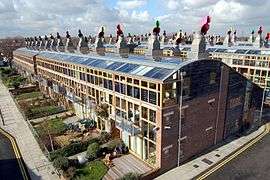

- BedZED (Beddington Zero Energy Development)
The acclaimed BedZED (Beddington Zero Energy Development) housing complex is located on London Road, SM6, about 500 yards north of Hackbridge mainline railway station. It uses a number of innovative technologies to enable it to operate with zero energy use. It was designed by the architect Bill Dunster to support a more sustainable lifestyle. The project was led by the Peabody Trust in partnership with Bill Dunster Architects, Ellis & Moore Consulting Engineers, BioRegional, Arup and the cost consultants Gardiner and Theobald.
The 99 homes, and 1,405 square metres of work space were built between 2000 and 2002. It is the UK's largest and first carbon-neutral eco-community. The buildings are constructed of materials that store heat during warm conditions and release heat at cooler times, and where possible, they have been built from natural, recycled or reclaimed materials. The first residents moved in (to the Helios Road part of the development) during March 2002.
BedZED receives power from a small-scale combined heat and power plant (CHP). In conventional energy generation, the heat that is produced as a by-product of generating electricity is lost. With CHP technology, this heat can be harnessed and put to use. At BedZED, the heat from the CHP provides hot water, which is distributed around the site via a district heating system of super-insulated pipes. Should residents or workers require a heating boost, each home or office has a domestic hot water tank that doubles as a radiator.
The CHP plant at BedZED is powered by off-cuts from tree surgery waste that would otherwise go to landfill. Wood is a carbon neutral fuel because the CO2 released when the wood is burned is equal to that absorbed by the tree as it grew.
The development has attracted wide interest and acclaim over the past decade since it was built, and, has won numerous awards. Among other examples of recognition, it was shortlisted for the Stirling Prize for architecture in October 2003, and won awards from the London Evening Standard and RIBA in 2002.
- Sutton Ecology Centre
The Sutton Ecology Centre is located in the Carshalton Village part of Sutton borough.[52] The Grounds are a 1.3 hectare Local Nature Reserve and Site of Borough Importance for Nature Conservation, Grade 1. It is owned by Sutton Council and managed by the Council together with the Friends of Sutton Ecology Centre.[53][54][55]
It is an area of mainly open space where visitors can find out about wildlife habitats, alternative energy, recycling, composting, and organic gardening. The centre's activities include running educational visits for schools and community groups, as well as events and volunteer days.
The history of the Ecology Centre is that the grounds were until the late eighties known as the "Lodgelands", named after the old gardens of The Lodge in Carshalton. They were used as a tree nursery until the early 1980s, when they became surplus to requirements. After a prolonged public debate, it was agreed in 1987 to preserve the area as an open space for public use.
- Carshalton Environmental Fair

The Environmental Fair is held in Carshalton Park on August Bank Holiday Monday.[56] It features over 100 stalls and showcases local sustainability initiatives. It also includes music, performing art, poetry, children's activities, campaign groups, local craft, interactive demonstrations, and a farmers' market. Music is performed from three stages and across the genres from rock to folk. The main stage is a natural open-air amphitheatre. There is food and a bar with real ales. The fair attracts on average around 10,000 people. It is organised by EcoLocal with a team of volunteers.
- Sutton Community Farm
Sutton Community Farm, the only one of its kind in London, is located in the Wallington part of the borough. A not-for-profit social enterprise, it occupies a 7.5 acre small-holding of a type originally given to ex-servicemen following the First World War.[57]
- Growing the green economy
The London Borough of Sutton has provided funding to grow the green economy by creating a low carbon cluster of green businesses. The project includes the establishment of a "Green Business Network", the provision of training, and the creation of employment opportunities for assessors, surveyors, designers and installers.[58]
- Straw-bale café
The café in Manor Park, Sutton has a range of environmental features, in particular its straw-bale construction. It was built in 2010 using UK produced straw-bales and natural sustainable materials, a type of construction which means that the building could last for longer than 200 years.[59] It was London’s first energy-efficient building to use this method of construction.[60]
Hospitals

St Helier Hospital (full title: St Helier Hospital and Queen Mary's Hospital for Children) in the London Borough of Merton and London Borough of Sutton is run by Epsom and St Helier University Hospitals NHS Trust along with Epsom Hospital. It is located next to the large St Helier estate and close to the major intersection known as Rosehill. The hospital offers a full range of hospital services including a 24-hour accident and emergency department. The site is also home to the South West Renal and Transplantation Service and the Queen Mary's Hospital for Children, a dedicated children's hospital. St Helier Hospital is a major teaching hospital for St George's, University of London, and is the second main teaching site for the clinical years of the medicine degrees outside of St George's Hospital.[61]
Transport
The main forms of public transport used in the borough are surface rail from its various regional railway stations and local buses.
Sutton has frequent, direct commuter rail services to central London stations, including London Victoria (approx 26 minutes travelling time depending on service), London Bridge and several Thameslink stations, including St Pancras (the Eurostar terminus). Sutton borough also has quick access to the London Underground with the Northern line in neighbouring Merton borough easy to reach by several local bus services. In addition, the recent London Overground network, completed c. 2010, is only 5 to 10 minutes away from Sutton borough stations at neighbouring Croydon borough station West Croydon. Sutton borough may also join up fully with the nearby London Tramlink that currently serves places like Croydon and Wimbledon, with discussions about it becoming part of this network at an advanced stage: as of mid-2014, a consultation was taking place into options for the route of a proposed extension from Wimbledon to Sutton.[62][63]
National and international travel
Sutton is linked into the national motorway network via the A217 and M25 orbital motorway at Junction 8. The M25 skirts the south of the borough, linking Sutton with other parts London and the surrounding counties. The A24 passes through the north western part of the borough, through North Cheam and onto Epsom, Dorking, Horsham, Worthing, Bognor Regis and Chichester. This follows, in part, the course of Stane Street, an old Roman road linking London and Chichester. The A232 links Sutton with other towns in the borough, also the boroughs of Kingston, Croydon and Bromley.
_railway_station.jpg)
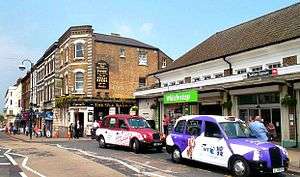
The Sutton and Mole Valley Lines railway route south from Sutton links the borough to Sussex and Surrey to the south, and to central London to the north: providing direct services to Dorking, Epsom, Horsham, Leatherhead, Wimbledon, Croydon and Wandsworth. Also running through Sutton is the Sutton Loop Thameslink line which links Luton and St Pancras International directly with the stations on the loop. The main station for all these services is Sutton railway station to the south of the town. The station is the largest and busiest in Sutton. Passenger rail services through Croydon are provided by Southern and First Capital Connect.[64] A pilot scheme launched by the Strategic Rail Authority, Transport for London and three train operators is designed to encourage more passengers to travel off-peak. In full partnership with the South London Boroughs which includes Sutton, SWELTRAC, SELTRANS and the transport users group, the scheme promotes the advantages of off-peak travel following improvements to safety, travel connections and upgrading of station facilities. The Thameslink Programme (formerly known as Thameslink 2000), is a £3.5 billion major project to expand the Thameslink network from 51 to 172 stations[65] spreading northwards to Bedford, Peterborough, Cambridge and King's Lynn and southwards to Guildford, Eastbourne, Horsham, Hove to Littlehampton, East Grinstead, Ashford and Dartford. The project includes the lengthening of platforms, station remodelling, new railway infrastructure (e.g. viaduct) and additional rolling stock.
Sutton is located about 15 miles (24 km) from both London Heathrow Airport and London Gatwick Airport. Heathrow is served by London Buses route X26 and Gatwick by the National Express Coaches A3 route, which stops outside Sutton railway station. Luton Airport, about 40 miles (64 km) to the north, is connected to Sutton by a direct train. Croydon Airport which was partly in the borough of Sutton served as London's main airport in the years prior to the second world war but closed in the 1950s.
Local travel
The hilly topography of Sutton and the lack of underground services in South London is a reason for the extensive suburban and inter-urban railway network. Sutton is in the commuter belt to London as part of suburbia. There are several busy local rail routes running along the borough's towns, connecting it with London Bridge, St. Pancras International (the Eurostar terminus) and London Victoria. These local routes mainly run on the Sutton Loop and Sutton & Mole Valley Lines. As well as the main station of Sutton, there are several suburban stations at Hackbridge, West Sutton, Carshalton and Cheam and more.
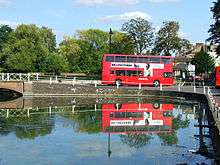

A sizeable bus infrastructure which is part of the London Buses network operates from a main hub on the Sutton one-way system. London General, owned by the Go-Ahead Group, is one of the largest bus operators to serve Sutton along with Metrobus, Abellio London, London United and Quality Line. Unlike other places in the country, London's transport infrastructure is regulated and therefore is not subject to price wars between different companies with TfL setting a standard price for bus services which is currently £1.35 with an Oyster card and free for all under 12s. Services include buses to central London, Croydon, Wimbledon, Kingston and a number of other civic centres in the south. London Buses route X26, the longest route in London, provides services between Heathrow airport and Croydon via Kingston.
Although hilly, Sutton is compact and has few major trunk roads running through it. It is on one of the National Cycle Network routes running around South London.[66] Data from the 2011 Census states that the cycle mode share for people cycling to work has fallen from 2.1% to 1.5% since 2001. The average cycle mode share in Sutton from 2008/09 to 2010/11 was 1.5%.[67] The nearby North Downs to the south, part of which falls within the borough boundary, is an area of outstanding natural beauty popular with both on and off-road cyclists.
Construction of the East London line extension to West Croydon was completed c. 2010. Sutton borough has easy access to this tube extension via its frequent and quick services to West Croydon station (along with various other routes into central London) – for instance the journey time from Sutton mainline station to West Croydon station is 10 minutes. Parliamentary approval to construct a railway line from Wimbledon to Sutton through what were then undeveloped rural areas had been obtained by the Wimbledon and Sutton Railway (W&SR) in 1910. The main supporters of the scheme were the London Brighton and South Coast Railway (LB&SCR), the London and South Western Railway (L&SWR) and the District Railway (DR, now London Underground's District line). All held shares in the company and had rights to run trains over the line when built. World War I prevented any work taking place and by the early 1920s continuing financial support from the DR meant that it had effectively taken control of the company. Through its ownership of the DR, the London Electric Railway (LER, precursor of London Underground) was able to obtain approval to use part of the route for an extension of the City and South London Railway (C&SLR, now the Northern line) from Clapham Common through Morden to Sutton. The route would have seen Underground Northern line trains running on surface tracks from Morden past the nearby Underground depot and on to the Network Rail alignment close to Morden South. The Southern Railway (SR, successor of the L&SWR and the LB&SCR after the 1923 Grouping of railways) objected to this encroachment into its area of operation and the loss of its passenger traffic to a more direct route. The two companies reached an agreement that enabled the C&SLR to extend as far as Morden in exchange for the LER giving up its rights over the W&SR route. The SR subsequently built the line, one of the last to be built in the London area. It opened on 5 January 1930.
In March 2011, the main forms of transport that residents used to travel to work were: driving a car or van, 33.1% of all residents aged 16–74; train, 6.6%; bus, minibus or coach, 6.6%; on foot, 5.6%; underground, metro, light rail, tram, 3.9%; work mainly at or from home, 3.1%; passenger in a car or van, 2.0%; cycling 1.5%.[68]
Parks and open spaces
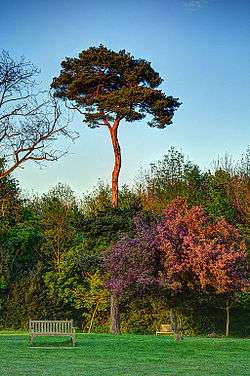
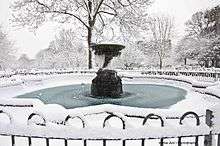

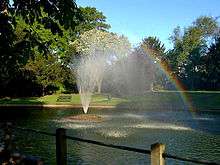

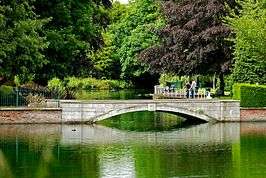
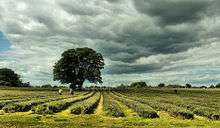

In total, the London Borough of Sutton has 89 parks and open spaces within it boundaries, representing a total area of 1,500 acres (6.1 km2).
Main parks
Varied in size and layout, green spaces range from the compact Manor Park in Sutton town centre and Sutton Green just to the north of Sutton town centre, through the medium-sized Grove Park, which forms a notable part of the Carshalton conservation area, to the large and historic Oaks Park in the south of the borough. In the west of the borough is the large Nonsuch Park.
Just to the north of Sutton town centre there is more extensive green space in the form of Sutton Common, which originally (until the beginning of the 19th century) encompassed the aforementioned Sutton Green. Today, a small portion of Sutton Common is given over to a major junior tennis facility. The common extends both to the east and west of Angel Hill. Slightly further in the opposite direction out of Sutton lie Banstead Common and Banstead Downs—these start a few hundred yards from the southern end of the town, and extend for an additional mile south in the direction of neighbouring Banstead.
Manor Park was created in 1914 on a site in the town centre opposite the police station. Its grounds include the Sutton War Memorial, which was added in 1921. A fountain was added in 1924. In 2010 its new café of straw-bale construction was London's first environmentally friendly building to use this building method.
Features of interest in the Victorian Grove Park include a white Portland stone bridge, known as the Leoni Bridge where Lower Pond meets the park. Upper Mill is recent reconstruction of a watermill that has existed here from Anglo-Saxon times. The cascade is near the footbridge towards the Stone Court corner of the park. The 1.5m fall is now ornamental in design and was reconstructed in the 1960s. Its original purpose was to create a head of water to power Upper Mill.
Oaks Park has a long history. It was substantially laid out for the Earl of Derby in the 1770s, but its villa dates back to around 1750 and is in that era's fashionable landscape style, with trees forming a perimeter screen and placed in artful clumps to suggest a natural landscape.[69]
Nonsuch Park near Cheam in the west is the last surviving part of the Little Park of Nonsuch, a deer hunting park established by Henry VIII of England surrounding the former Nonsuch Palace. The name "Nonsuch" was given as, it was claimed, there was "none such place like it" in Europe.[70]
List of parks
The main parks in the borough are:
- Beddington Park
- Carshalton Park
- Cheam Park
- Grove Park
- Lakeside
- Manor Park, Sutton town centre
- Mellows Park
- Nonsuch Park
- Oaks Park
- Rosehill Park East and West
- Overton Park
- Poulter Park Poulter Park
- Queen Mary's Park
- Roundshaw Down
- Royston Park
- Seer's Park
- St Helier Open Space
- The Wandle Walkway
Local nature reserves
In addition, Sutton borough contains a large number for its size of Local Nature Reserves:[71]
- Anton Crescent Wetland has ponds, willow carr and reedbeds, and the ponds never dry out as the rock formation is Oxford Clay. The pools and mud provide a habitat for birds such as the green sandpiper and common snipe.
- Belmont Pastures is a long narrow triangle north of Belmont railway station. It is an old meadow which formerly belonged to Belmont Hospital.
- Cuddington Meadows is mainly chalk grassland with some scrub. Its most important feature is a variety of unusual flowering plants, including greater knapweed, lady's bedstraw and field scabious.
- Devonshire Avenue Nature Area is mainly neutral grassland, but it has areas of chalk grassland, scrub and trees. A notable species is the small blue butterfly, which is rare in the borough. Plants include the nationally scarce ivy broomrape, and kidney vetch and bird's-foot trefoil.[72]
- Roundshaw Downs was in the 19th century an area of farmland, becoming in the first half of the twentieth Croydon Airport.[73] Most of the site is a mixture of chalk and neutral grassland, but there is also some woodland. Areas of unimproved chalk grassland have species typical of this habitat such as common quaking grass, wild carrot and bird's-foot-trefoil. A grassland flower species is greater yellow rattle, which is nationally protected, and Sutton and Croydon are its national strongholds.
- Ruffett and Big Woods on the edge of the borough near Woodmansterne are the largest continuous area of woodland in the borough. Ruffett Wood is mainly sycamore, with some ash and hazel. It also has some plant species indicative of ancient woodland, such as bluebells. Big Wood has even more sycamore, as well as two large oaks and a stand of wood anemone. The site also has numerous bird species.
- Spencer Road Wetlands has since 1991 been managed by the London Wildlife Trust. The site has reed swamps with wetland vegetation, woodland, a sedge-bed and a pond. Insects include the twin-spotted wainscot and crescent moths, and there are birds such as grey heron, reed warbler and kingfishers.
- Sutton Ecology Centre Grounds is in Carshalton and owned by Sutton Council and managed by it and the Friends of Sutton Ecology Centre. Habitats include ponds, woodland, meadows, marshlands. There are also small demonstration gardens. In the south is the old course of the River Wandle, which in now dry most of the time, but still has yellow flag iris. Margaret's Pool has a number of species of dragonfly and damselfly, and the trees surrounding it are sycamore and ash.
- The Spinney, Carshalton, a small L shaped reserve, is a mixture of woodland and scrub, with the main trees being plane and elm. Breeding birds include dunnocks, wrens and blackbirds. Other animals include wood boring beetles and foxes.
- Wandle Valley Wetland has open water and seasonal pools, scrub and wet woodland. There are frogs, toads and newts, together with brown hawker dragonflies and birds including blackcaps and wrens.
- Wilderness Island, near Carshalton, is a 2.7 hectare island between two arms of the River Wandle and was once the site of a pleasure garden. It features a fish pond, woodland, and meadows. Trees include the black poplar, and there are birds such as the woodpecker, kingfisher and grebe. There is a variety of butterflies including the speckled wood and holly blue, and the rare hornet clearwing moth.
Lavender fields
There are two historic lavender fields in the borough. One, at Oaks Way, Carshalton Beeches is a not-for-profit community project that manages three acres of lavender. The other, a 25-acre commercial site in Croydon Lane called Mayfield, is popular with tourists. This area was once famous as the "Lavender Capital of the World". From the 18th to the early 20th centuries the North Downs of Surrey, with its chalky free-draining soil, ideal for lavender growing, were at the centre of worldwide production of lavender. It was a very prosperous part of the local agriculture. Blue fields could be seen all over Mitcham, Croydon, Wallington, Banstead, Carshalton and Sutton.[74] The scale of the operation can be understood from the fact that the Daily News in 1914 was able to state:
| “ | At Carshalton Beeches in every direction the low hill sides of the farm beyond Beeches Halt are swept with the bloomy pastel tint of the lavender flowers. | ” |

Sports facilities and clubs
Football club Sutton United F.C. are based in Sutton at Gander Green Lane and play in the National League. Sutton Common Rovers also share the ground with Sutton United. Carshalton has two football clubs: Carshalton Athletic F.C. (home ground at The War Memorial Sports Ground, Colston Avenue, and play in the Ryman League) and Carshalton FC (at Beddington Park).
Wallington has a Non-League football club Crescent Rovers F.C. who play at the Wallington Sports & Social Club.
The Croydon Pirates despite their name play just inside the borough of Sutton, at Waddon and are one of the most successful teams in the British Baseball Federation.
Sutton Cricket Club[75] is based in Cheam Road, Sutton, (entrance in Gander Green Lane.) The Club's 1st XI plays at the highest level of the sport available to it, the England & Wales Cricket Board's, 'Surrey Championship Premier Division.’
Mitcham Rugby Union Football Club[76] plays out of Poulter Park in Carshalton, Wandle Valley ward. Mitcham RUFC play in the Surrey RFU Leagues. Poulter Park also boasts three Gaelic clubs that use Mitcham RUFC as a base for training and playing games Round Towers GAA, Senior Gaelic Football Club,[77] Sean Treacy's Hurling Club[78] and Croydon Camogie Club.[79]
Rosehill boasts an ETTA premier level Table Tennis Club, Rosehill TTC[80] who play in the Sutton & District League and the Thames Valley League.
At the Westcroft Leisure Centre, in Carshalton there are health and fitness facilities including two swimming pools, sports hall, squash court and fitness centre.[81] There is also a children's play area called Kid's Kingdom. Westcroft is also home to Sutton Pumas basketball club.
In 2012 Westcroft underwent a major renovation costing £11 million, bringing improved swimming facilities, a dance studio and beauty treatment rooms. There are eight courts in the sports hall, providing facilities for activities including badminton, gymnastics, trampolining, basketball, football, netball and volleyball.
In addition, Carshalton Library moved to the Westcroft centre, as part of the renovation.
There are also two public basketball courts in the Rosehill district of Sutton borough.
The Sutton and Epsom Weightlifting Club meet at Sutton Arena near to St Hellier's Hospital to the North of Sutton.
Climate
Sutton has a temperate climate in common with most areas of Great Britain, it is similar to that of Greenwich in Inner London: its Köppen climate classification is Cfb.[82] Its mean annual temperature of 9.6 °C is similar to that experienced throughout the Weald, and slightly cooler than nearby areas such as the Sussex coast and central London.[83] Rainfall is considerably below England's average (1971–2000) level of 838 mm, and every month is drier overall than the England average.[84]
The nearest weather station is at Gatwick Airport.[85][86]
Town twinning
.jpg)
.jpg)
.jpg)
Sutton's twin towns are as follows:[87]
- Gagny in France
- Gladsaxe in Denmark
- Minden in Germany
- Charlottenburg-Wilmersdorf in Germany
In addition, there is a friendship link with:
- Tavernelle in Italy
The Sutton twin towns mural on a building in Sutton town centre is made up of individual paintings of all the twin towns. The building is at the junction of Sutton High Street and Sutton Court Road.
See also
References
- ↑ "Meet Sutton's new mayor". Surrey Comet. Retrieved 15 February 2016.
- ↑ 2011 Census: Ethnic group, local authorities in England and Wales, Office for National Statistics (2012). See Classification of ethnicity in the United Kingdom for the full descriptions used in the 2011 Census.
- ↑ "Overview of London boroughs | London's Poverty Profile". Londonspovertyprofile.org.uk. 17 October 2013. Retrieved 17 September 2014.
- ↑ Evening Standard
- ↑ Sutton Press Office
- ↑ Sutton Council press release
- ↑ "Family Hotspots Report 2014". Family Investments. Retrieved 28 October 2014.
- ↑ "Super Sutton: Borough has most entries in top family places to live in London". Sutton Guardian. Retrieved 28 October 2014.
- ↑ Surrey Comet
- ↑ ITV News
- ↑ Telegraph Newspaper
- ↑ Physical Environment: Land Use Survey 2005 2011 census
- 1 2 "What is the Big Society?". Sutton London Borough Council. Retrieved 30 August 2014.
- ↑ Borough Profile
- ↑ "Secombe Theatre, Charles Cryer Studio Theatre". Retrieved 4 October 2014.
- ↑ "Open House London 2014". Archived from the original on 6 October 2014. Retrieved 4 October 2014.
- ↑ "Over the footlights website, regarding the Secombe Centre Theatre" (PDF). Retrieved 4 October 2014.
- ↑ "Sir Harry Secombe". Explore Gower. Retrieved 14 October 2014.
- ↑ Theatre Trust website
- ↑ "Sadler's Wells Theatre" (PDF). Overthefootlights.co.uk. Retrieved 26 June 2014.
- ↑ "Secombe Theatre". UK Attraction. Retrieved 4 October 2014.
- ↑ Ian Youngs (18 September 2014). "Theatres Trust lists 33 historic theatres 'at risk'". BBC. Retrieved 4 October 2014.
- ↑ "Comic legend Tim Vine takes to Twitter to call on Sutton Council to halt theatre closure plans". Sutton Guardian. 17 September 2014. Retrieved 4 October 2014.
- ↑ "Four bids to take over Sutton's theatres invited to submit full business case". London Borough of Sutton Press Office. Retrieved 18 December 2014.
- ↑ "Dramatic rescue for Sutton's theatres as new 10-year takeover deal gets nod". Sutton Guardian. 21 January 2015. Retrieved 22 January 2015.
- ↑ Beddington Place (Great Hall Only) – Sutton – Greater London – England. British Listed Buildings. Retrieved on 17 July 2013.
- ↑ Pigeon House to the North West of Beddington Place – Sutton – Greater London – England. British Listed Buildings. Retrieved on 17 July 2013.
- ↑ Parish Church of St Mary the Virgin, Sutton
- ↑ London Borough of Sutton
- ↑ "London Borough of Sutton Heritage, Little Holland House.".
- ↑ London Borough of Sutton – Sutton Central Library. Sutton.gov.uk. Retrieved on 17 July 2013.
- ↑ "Sutton Life Centre", sutton.gov.uk. Retrieved 1 March 2011.
- ↑ "Deputy Prime Minister Nick Clegg officially opened Sutton Life Centre", Sutton Guardian, 27 October 2010. Retrieved 1 March 2011.
- ↑ "Honeywood Museum History". Friendsofhoneywood.co.uk. 1 December 1990. Retrieved 26 June 2014.
- ↑ "Press Release". Arts Network Sutton. Retrieved 29 November 2014.
- ↑ Drostle and Turner fine tiles — Sutton Heritage page
- ↑ http://www.friendsofwhitehallcheam.co.uk/Whitehall_History.htm Whitehall History
- ↑ Sutton Guardian 7 April 2016
- ↑ Friends of Nonsuch
- ↑ London Borough of Sutton article
- ↑ DoE list of buildings of special architectural or historical interest
- 1 2 H.E. Malden (editor) (1912). "Parishes: Carshalton". A History of the County of Surrey: Volume 4. Institute of Historical Research. Retrieved 29 November 2012.
- ↑ "Famous people that lived in your area – General Discussion – Digital Spy Forums". Forums.digitalspy.co.uk. Retrieved 26 June 2014.
- ↑ SUTTON TOPS GCSE LEAGUE TABLES (From Your Local Guardian). Yourlocalguardian.co.uk (31 January 2012). Retrieved on 17 July 2013.
- ↑ "LIVE: Sutton GCSE results day 2013 (From Sutton Guardian)". Suttonguardian.co.uk. 23 August 2013. Retrieved 26 June 2014.
- ↑ Anna Davis (23 January 2014). "GCSE league tables: One in three London pupils leave school without five good grades – Education – News – London Evening Standard". Standard.co.uk. Retrieved 26 June 2014.
- ↑ "Sutton's primary schools hailed as 'particularly impressive' by Ofsted (From Sutton Guardian)". Suttonguardian.co.uk. 2 January 2014. Retrieved 26 June 2014.
- ↑ Sutton Guardian
- ↑ Times Educational Supplement
- ↑ "Sutton schools to get £8m boost – fourth largest funding increase in the country (From Sutton Guardian)". Suttonguardian.co.uk. 14 March 2014. Retrieved 26 June 2014.
- ↑ "Grammar schools to save places for Sutton pupils in landmark move (From Sutton Guardian)". Suttonguardian.co.uk. 22 May 2014. Retrieved 26 June 2014.
- ↑ London Borough of Sutton – Sutton Ecology Centre. Sutton.gov.uk. Retrieved on 17 July 2013.
- ↑ "Sutton Ecology Centre Grounds". Local Nature Reserves. Natural England. 7 March 2013. Retrieved 29 March 2014.
- ↑ "Map of Sutton Ecology Centre Grounds". Local Nature Reserves. Natural England. Retrieved 29 March 2014.
- ↑ "Sutton Ecology Centre". Greenspace Information for Greater London. 2013. Retrieved 29 March 2014.
- ↑ "Carshalton Environmental Fair".
- ↑ Sutton Community Farm
- ↑ Institute for Sustainability
- ↑ "A new café made of straw! This exciting eco-friendly building is Manor Park Café". London Borough of Sutton. Retrieved 19 October 2014.
- ↑ "Three little pigs and a straw house – is Sutton becoming a fairytale?". Sutton Guardian. Retrieved 19 October 2014.
- ↑ Epsom St Helier website
- ↑ http://www.newsroomsutton.co.uk/?p=746
- ↑ http://www.suttonguardian.co.uk/news/11357417.Have_your_say_on_Wimbledon_to_Sutton_Tramlink_extension_as_four_possible_routes_are_revealed/?ref=var_0
- ↑ "UK rail network map" (PDF). National Rail website. National Rail. 2006. Archived from the original (PDF) on 30 May 2008. Retrieved 25 May 2008.
- ↑ "Good news for South London as £3.5BN Thameslink project clears major hurdle" (Press release). 18 October 2006. Retrieved 12 April 2007.
- ↑ "Areas to cycle in Sutton". 2008. Retrieved 24 May 2008.
- ↑ "Roads Task Force - Technical Note 4" (PDF). Transport for London. Retrieved 27 October 2016.
- ↑ "2011 Census: QS701EW Method of travel to work, local authorities in England and Wales". Office for National Statistics. Retrieved 23 November 2013. Percentages are of all residents aged 16–74 including those not in employment. Respondents could only pick one mode, specified as the journey's longest part by distance.
- ↑ "The Oaks & Oaks Park, London Borough of Sutton".
- ↑ Nonsuch: A Lost Tudor Palace, Philippa Glanville
- ↑ "Local Nature Reserves: Search results for Greater London". Natural England.
- ↑ "Devonshire Avenue Nature Area LNR". London Borough of Sutton. Retrieved 28 March 2014.
- ↑ "Roundshaw Downs LNR". London Borough of Sutton. Archived from the original on 13 April 2014. Retrieved 17 March 2014.
- ↑ "Mayfield Lavender".
- ↑ Sutton Cricket Club
- ↑ Mitcham Rugby Union Football Club
- ↑ Round Towers GAA, Senior Gaelic Football Club
- ↑ Sean Treacy's Hurling Club
- ↑ Croydon Camogie Club
- ↑ Rosehil TTC
- ↑ "L.B. Sutton – Westcroft Leisure Centre.".
- ↑ WorldClimate
- ↑ "Mean Temperature Annual Average". Met Office. 2001. Retrieved 22 August 2007.
- ↑ "Met Office: averages 1971–2000". Met Office website. Met Office. 2007. Retrieved 22 August 2007.
- ↑ (Rainfall data)
- ↑ (Pressure data)
Temperature and rainfall: 1961–1990 averages. Pressure averages: 1971–1988 averages.
Derived from the Global Historical Climatology Network (version 1). - ↑ London Borough of Sutton Town Twinning page
External links
| Wikimedia Commons has media related to London Borough of Sutton. |
| Wikivoyage has a travel guide for London/South_West. |
